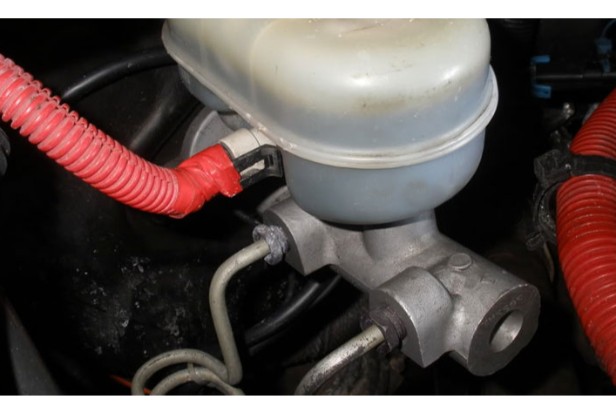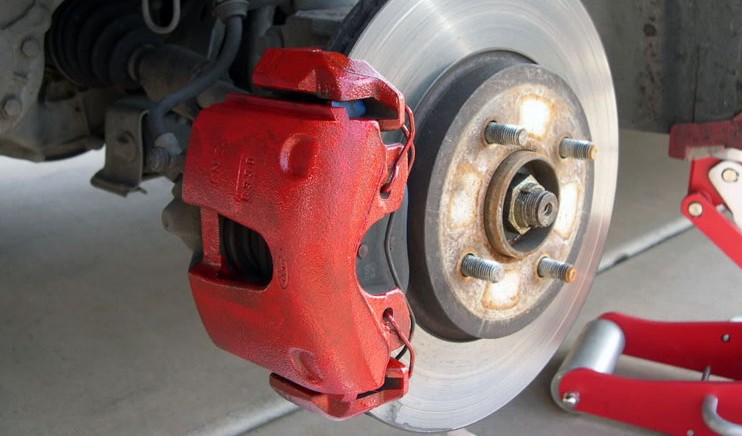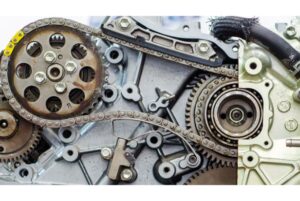
What Are the Main Parts of a Braking System – Brake Parts Explained
You are aware that the car will slow down when you depress the brake pedal. It sounds easy, but what components of the braking system enable stopping and slowing down?
Understanding the components of a car brake system can help you recognize when a component needs to be repaired or replaced as well as when it’s time to seek out maintenance services. Read on to discover the essential components of a braking system and what to look for when they start to fail.
Master Cylinder
The brake master cylinder, which starts the rest of the braking system in motion, is the first and possibly most crucial part of your braking system. When the brake pedal is depressed, a piston is forced through the master cylinder, forcing brake fluid through the brake lines.
In other words, the master cylinder produces hydraulic pressure that pushes brake fluid all the way down to the brake parts on each wheel. The master cylinder receives fluid from the brake fluid reservoir, which is positioned on top of it.
Symptoms Of A Bad Master Cylinder
Although master cylinders are made to last the entire life of your car, they occasionally develop leaks or other mechanical issues. Look out for these symptoms of a bad master cylinder:
- Abnormal brake pedal feel: The master cylinder may have a leak or otherwise not be properly sealed if the brake pedal is soft, squishy, or slowly sinks to the floor.
- Dirty brake fluid: The master cylinder’s rubber seals may have worn out and contaminated the brake fluid if the fluid has a dark brown or black appearance.
- Leaking fluid: Brake fluid may drip onto the ground beneath your car from a master cylinder whose seals have worn out.
- Check engine light: A defective master cylinder can cause the brake system to lose pressure, which can activate sensors in your car and turn on the check engine light.
Brake Booster
In a power braking system, the brake booster is fixed to the firewall behind the master cylinder. A rubber diaphragm separates the booster’s two chambers in its shell. When the brake is applied, a diaphragm valve is closed and a different valve is opened, allowing air to enter the chamber on the pedal side. The booster amplifies the applied foot pressure so that the amount of pressure required to stop is as little as possible by using an intake stroke of the engine to create this vacuum.
Symptoms Of A Bad Brake Booster
By making braking more challenging, a brake booster that is failing can lead to hazardous driving situations. Brake boosters frequently stop working because of a ruptured diaphragm or cracked vacuum hose. Here’s what to look for if you suspect your brake booster may be going bad:
- Stiff brake pedal: One of the key signs of a bad brake booster is a brake pedal that is difficult or impossible to press down and does not rise after being pressed.
- Longer stopping distance: a vehicle with a bad brake booster may be more difficult to stop and could result in longer stopping distances.
- Engine stalls when braking: Your engine may experience excessive vacuum draw if the brake booster diaphragm in your vehicle ruptures, leading to a stall.
Brake Fluid
The mechanical components of your brake system are activated by pressurized brake fluid. It travels from the master cylinder to the brake fluid reservoir. In the event that the vehicle has rear drum brakes, the brake pads are then routed through the brake lines and down to the calipers or wheel cylinders at each wheel. This hydraulic fluid maintains the health of your brake system by acting as a lubricant and containing anti-corrosion additives in addition to actuating the brake pads and rear shoes at each wheel (if drum brakes are equipped).
Symptoms Of Bad Brake Fluid
Every two years or 30,000 miles, you should investigate changing your brake fluid as part of routine maintenance. If your brake fluid is contaminated, sludgy, or its level is too low, you may encounter these symptoms:
- Soft brake pedal: A leak that has caused you to lose too much brake fluid may be indicated by a pedal that is excessively soft and unresponsive.
- Less effective brakes: Longer stopping distances could result from brake fluid that is air or sludge contaminated because it won’t respond as well to pressure.
- Brake warning light: The brake warning light on your dashboard may be activated by a sensor in the brake fluid reservoir of your car if fluid levels fall too low.
Brake Lines & Hoses
From the master cylinder to the calipers on each of the four wheels, brake lines and hoses transport brake fluid. The majority of the fluid’s journey to the wheels is made by brake lines, which are firmly fastened metal tubes to the car’s frame. The fluid is transported the remaining distance to each caliper or wheel cylinder using brake hoses, which are located at the end of the brake lines. Rubber brake hoses are used to allow movement between the wheel and suspension.
Symptoms Of Bad Brakes Lines & Hoses
Despite the fact that brake lines and hoses are built to last for tens of thousands of miles, they should still be checked frequently for leaks or other damage. Here’s how to check if your brake lines or hoses are going bad:
- Mushy brake pedal: A line or hose leak could affect the hydraulic fluid pressure required by your brakes, resulting in a dangerously spongy pedal.
- Visibly worn brake hose: Brake hoses that have experienced weather and heat from the brakes over time may have cracks, tears, or frayed threads, which can quickly cause a leak.
Brake Caliper
- What they are: The brake pads, brake pistons, and brake fluid are all contained in the calipers, which can be either floating or fixed. Imagine them as a clamp. They are essential for generating the friction that slows down your brake rotors or discs.
- How long they last: How frequently you use your car has a big impact on the lifespan of the calipers. The caliper may degrade, stick, or gather debris if it is left idle for an extended period of time. A seized brake caliper might also need to be fixed. However, with proper maintenance, calipers can generally last a very long time.
- When to replace: As a result of the heat generated by the brake system, the seals on brake calipers are typically where problems arise. However, the disc and caliper rubbing against one another can also cause grinding. Each 12,000 miles have the rest of your brake system and your calipers inspected.
Brake Pads & Shoes
- What they are: Brake pads, another element of disc brakes, exert pressure on the brake rotors or discs to slow them down. The brake pistons engage them, which are located in the brake calipers.
- How long they last: The durability of a brake pad is influenced by its quality. Harder pads last longer than soft pads, but overall, they’ll last until the padding is worn down to the metal “shoe” part of the brake pad. Pads typically last 40,000 miles, but their lifespan can range from less than 25,000 miles to more than 65,000 miles.
- When to replace: Squealing is a reliable sign that your brake pads need to be repaired. A brake warning sensor is found in many cars, and it alerts you when it’s time to have your brake pads checked right away. The owner’s manual for your car will frequently tell you which brake pads are best for it. You can also try searching online discussion boards for a second opinion.
Symptoms Of Bad Brake Pads
Brake pads require regular replacement because they are a routine maintenance item. The lifespan of your brake pads can range from 20,000 to 70,000 miles, depending on the type you have. But looking at how thin they are can be a better indicator of whether your pads need to be changed. As soon as the thickness of the brake pads reaches 3 to 4 mm, they should be replaced. Here are some symptoms of worn-out brake pads:
- Squealing noise: Some brake pads have an integrated indicator that sounds an audible squealing sound when they get too thin, alerting you that they need to be replaced. If there is a loud grinding sound, the pads are most likely completely worn out and only the metal backplate is left to press against the rotor. To have your brake pads replaced as soon as possible, make an appointment if you hear grinding.
- Less effective brakes: As brake pads deteriorate, so does their braking performance, particularly when applying forcefully.

Brake Rotor & Drum
In the brake system, a drum and shoes work together. It is made of hard metal and, as the name suggests, is shaped like a drum. It rotates as a single mass as it slides over the wheel studs and is secured in place behind the wheel. Cast iron or steel brake drums have an interior surface that is perfectly smooth where the brake shoes meet. Additionally, it serves to safeguard the brake adjuster, wheel cylinder, and other hardware used in braking.
To slow the wheel from rotating so quickly inside a brake drum, the shoes spread out. Brake drums eventually wear out, but if they haven’t reached the point of being discarded, they can frequently be machined and used again.
Inside the drum, heat is produced as a result of shoe-drum friction. Brake drum operating temperatures typically range from 70 to 80 C.
Symptoms Of A Bad Brake Rotor
Although brake rotors last longer than brake pads, they also wear out over time from heat and friction, necessitating replacement at some point—typically after tens of thousands of miles. Sometimes rotors need to have their surfaces resurfaced or replaced entirely. Watch out for these symptoms of a bad brake rotor:
- Squealing or scraping noises: When applying the brakes, a warped rotor may make a squealing noise. If the rotor is severely worn, it may also make a scraping sound.
- Brake pedal vibrations: The brake pedal or steering wheel may vibrate erratically or unevenly if one or more rotors are warped.
- Grooves on the rotor: To maintain safe braking, the rotor may develop grooves or other obvious marks as brake pads and rotors wear out from contact. This may require resurfacing.
- Longer stopping distances: Warped, grooved, or scored rotors are generally less efficient and can dangerously extend your stopping distance.
Which Types Of Brakes Are There?
Most contemporary cars come equipped with two to three different kinds of brakes. These comprise the parking brake, drum brakes, and disc brakes. When you press the brake pedal, both drum and disc brakes do the same thing: they slow your car down. However, they do it using different parts.
All four wheels of most cars have disc brakes, though some may have drum brakes on the back wheels because they are less expensive to produce. Here’s a quick breakdown of each type of brake:
- Disc Brakes: In a typical hydraulic brake system, brake pads are squeezed against a rotating disc rotor by pistons located in calipers at each wheel.
- Drum Brakes: Uncommon hydraulic brake system uses wheel cylinders to force brake shoes against a rotating drum inside each wheel.
- Anti-Lock Brake System (ABS): An automatic emergency braking system that quickly pumps the hydraulic brakes using sensors in order to keep them from locking up in emergency braking situations
- Parking Brake: The emergency brake is a mechanical (and occasionally electronic) braking system that typically locks the wheels in place on slopes using a hand-operated lever.
Conclusion
After understanding the components, let’s examine the operation of the braking system. When the brake pedal is depressed, high-pressure brake fluid from the master cylinder enters the caliper and forces the piston into the interior of the brake pad and onto the disc rotor surface. By pulling the outer brake pad against the other side of the disc rotor and creating friction, the hydraulic pressure will cause the caliper to move along the slide pins, slowing both the brake and the car.


Average Rating